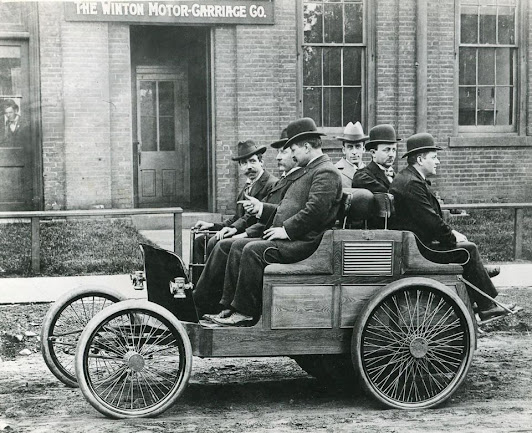All great human deeds both consume and transform their doers. Consider an athlete, or a scientist, or an artist, or an independent business creator. In the service of their goals they lay down time and energy and many other choices and pleasures; in return, they become most truly themselves. -Lois McMaster Bujold, author (b. 2 Nov 1949)
-----------------
I never heard of a trap as a conveyance but I can look at other vehicles that helped people get from one place to another (mostly on wheels).
Sepia Saturday's suggestion of trap and ponies this week...
Alix Winton in his experimental motor car in 1896.
An early ambulance operated by St John. The patient was placed in a coffin-like sidecar and the lid was closed for transport. There were however a couple of hatches.
An early food truck in Washington DC 1919
Henry Ford in 1933, thirty years after his first Model A was shipped, sitting in his then vintage Ford Model A next to a very vintage horse and carriage
via Alamy
1903 - Harley Davidson’s first factory - and speaking of motorcycles...

Filling up an Indian motorcycle - isn't it great they sold Shell and Texaco at the same gas station?
The Kentucky Pack-horse librarian of the WPA brought brochures and books to those who lived in the Appalachian mountains.Bristol UK, 1900 and 2020.
I really love then and now photos.
.jpg)









.jpg)

A lovely collection of "getting around" memories. I grew up knowing what a "pony and trap" was; my mother used to drive one when she was no more than twelve - the family moved out of London to escape the bombing and went to a remote cottage, the pony and trap was the only way to get to the shops. I've never seen an ambulance-sidecar before, though regular motorcycle sidecars were quite the thing when I was growing up. You rarely see one today.
ReplyDeleteGreat to know your mom drove a pony and trap as a girl. Better than walking I imagine. I hadn't ever seen the ambulance side-car before, but it was suggested as interest over on FB.
Delete...these are great, my favorite is the girl mechanics.
ReplyDeleteIt's a great photo shot, posed of course!
DeleteVery interesting presentation this week. Oddly enough, I just saw that St John Ambulance pic yesterday. I don't recall ever seeing it before. Are we at some sort of an anniversary that it is showing up now?
ReplyDeleteAh ha, we must have some intersection of FB algorithms. That's where most of my sepia photos come from these days...and there are certainly a lot for me that I didn't expect. Now just waiting for a meme suggestion to use some of them!
DeleteI love that then and now stuff, too!
ReplyDeleteMy FB algorithm is sending me oodles of sepia photos these days...is there no end?
DeleteHello,
ReplyDeleteLove the photos and the collection of vintage vehicles. Have a happy weekend.
Thanks, and surprisingly enough, FB hasn't given me any more to look at today! Have a great weekend Eileen and family!
DeleteThe Bristol photo is of Clifton High street... interesting seeing the canopies out in the older photo and the bare frontages in the later one
ReplyDeleteOh that's great that you recognized it. So glad to hear about the details!
DeleteWonderful photos! Especially the early swamp buggy.
ReplyDeleteAh, they soon learned about fatter tires, I imagine!
DeleteBarbara, I love old cars and trucks as well as boats, ships and airplanes. We've visited and photographed lots of autos and trucks...and I've posted info about them on my site as well. However, I like that fact that your post places the vehicles in an appropriate period setting. Take Care, Big Daddy Dave
ReplyDeleteThe old vehicles in their own times are really interesting, because usually there are people there too, dressed as they would have. I'm afraid I'll be out of town for the antique car show this summer here.
DeleteThen and now photo is my favorite. I love seeing these types of photos.
ReplyDeleteThanks...I'll keep an eye out to find more!
DeleteThese are great--that last one is awesome--although a bt tippy, I would think.
ReplyDeleteSome inventive young men I would imagine. I doubt if it worked very well in mud!
DeleteThis is an amusing bunch of photos. Thanks.
ReplyDeleteGlad you enjoyed them!
DeleteQuite a throwback.
ReplyDeleteAnd most of these newer machines were developed within the last 100 years. Of course the horses pulling things were much older.
DeleteAnother wonderful medley on the theme! Looking at the image of a Bristol street gave me a light bulb moment to suddenly realize that back in the day of horse-drawn vehicles, especially around WNC, traffic going uphill had a much slower pace than that coming downhill. Uphill must have been hard on the horses, while going downhill was dangerous braking for the driver.
ReplyDeleteGood catch there. I'd never thought of how that would affect two way traffic on city streets with horses pulling conveyences!
DeleteAs I scrolled through your photos, I realized that every one made me smile for one reason or another ... until I got to that ambulance. My claustrophobic self winced at the cover enclosing him in a "coffin."
ReplyDeleteYes, that does look like a coffin, the way he's lying there. He should have at least looked injured somehow!
DeleteA wonderful collection of vintage images. My favourite has to be the Irish mail cart. The passengers do look rather precarious sitting on it and are probably in for a rough ride!
ReplyDelete